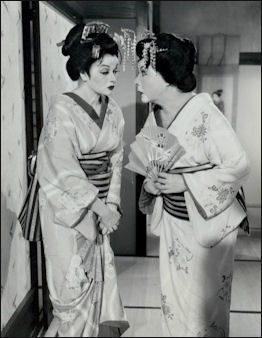FAMOUS JAPANESE ACTORS AND AMERICAN ACTRESSES AND JAPAN
Lucy Goes to Japan One of the most popular prewar actors in Japan was Chojito Hayashi, who appeared in classic films such as “Kurotegumi Sukeroku” (“Sukero of the Black Hand Gang” 1929). Hayashi, whose real name was Kazuo Hasegawa, made his screen debut in 1927 and appeared in more than 301 films before his death at 76 in 1984
Japan-born actress Tura Santana (1939-2011) was often referred to as “the Arnold Swartzenegger of bad girls.” She became famous after playing on the 1965 movie “Faster, Pussycat! Kill! Kill!”
Good Websites and Sources: Japanese Actors on M-Dream m-dream.co.uk/people/japanese-actors ; Japanese Actresses on M-Dream m-dream.co.uk/people/japanese-actresses ; Japanese Actors on Spcent.tv spcnet.tv/japanese-actors ; Japanese Actresses on Spcent.tv spcnet.tv/japanese-actresses ; Toshiro Mifune toshiromifune.org ; Ken Watanabe on Filmfone moviefone.com/celebrity/ken-watanabe
Japanese Commercials with Hollywood Actors Japander japander.com/japander ; Film Junk filmjunk.com ; Weird Asian news weirdasianews.com ; Gaijin a Go Go gaijinagogo.com
Links in this Website: JAPANESE FILM Factsanddetails.com/Japan ; CLASSIC JAPANESE FILMS AND FILMMAKERS Factsanddetails.com/Japan ; AKIRA KUROSAWA FILMS Factsanddetails.com/Japan ; GODZILLA Factsanddetails.com/Japan ; MODERN JAPANESE FILM INDUSTRY Factsanddetails.com/Japan ; MODERN JAPANESE FILMMAKERS AND FILMS Factsanddetails.com/Japan ; JAPANESE ACTORS AND HOLLYWOOD ACTORS IN JAPAN Factsanddetails.com/Japan ; HOLLYWOOD FILMS ABOUT JAPAN Factsanddetails.com/Japan
Books: “A Hundred Years of Japanese Film” by Donald Richie (Kodansha International, 2002); “Japanese Cinema — An Introduction” by Donald Richie (Oxford University, 1990). Good Websites and Sources on Japanese Film: Google e-book: A Hundred Years of Japanese Film by Donald Richie books.google.com/books ; Midnight Eye midnighteye.com ; Japanese Movie Listing lisashea.com/japan ; Kinema Club pears.lib.ohio-state.edu/Markus ; Japan Association for the International Promotion of the Moving Image unijapan.org/en ; Toei Uzumasa Movie Land is a theme park and movie studio were many samurai and historical drams have been shot. Website: Japan Guide japan-guide.com Asian Film Asia Society on Film asiasociety.org ; iFilm Connections — Asia and Pacific asianfilms.org ; Love Asia Film loveasianfilm.com ; Senses of Cinema sensesofcinema.com ; Illuminated Lantern on Asian Film illuminatedlantern.com
Databases, Directories, Links: Internet Movie Database /www.imdb.com ; Directory of Interent Sources newton.uor.edu ; Japanese Film Resources at the University of Iowa lib.uiowa.edu/eac/japan ; Tokyo International Film Festival tiff-jp.net ; DVDs Japanese, Chinese and Korean CDs and DVDs at Yes Asia yesasia.com ; Japanese, Chinese and Korean CDs and DVDs at Zoom Movie zoommovie.com ; CD Japan cdjapan.co.jp ;
Yoshiko Yamaguchi and Li Xianglan
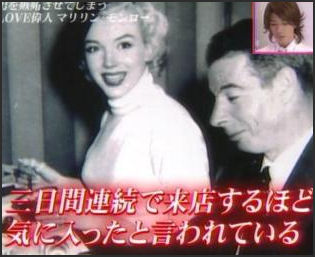
Marilyn Monroe and
Joe Dimaggio in Japan Yoshiko Yamaguchi, a beautiful doe-eyed singer and actress, was featured in a number of propaganda films in China the 1930s when the Japanese occupied Manchuria. Appearing under the pseudonym Li Xianglan, she caused a sensation in erotic melodramas like “China Nights” , about a love affair between a Chinese peasant and a heroic Japanese ship captain in wartime Shanghai. Her producers at the sinister Manchurian Film Association purposely hid her nationality. Most of her fans thought she was Chinese.
Yamaguchi (also also known as Ri Koran) was born in Manchuria to Japanese parents and grew up speaking both Mandarin and Japanese. When the war was over she fell into the hands of Chang Kai-shek’s nationalist forces, who charged her with collaborating with the enemy, a crime punishable by death. She was only spared execution when he was able to prove she was an ethnic Japanese.
But Yamaguchi's career didn’t end there. After the war she reinvented herself, first as the star of pro-American films and then as the Hollywood actress Shirley Yamaguchi, her name inspired by Shirley Temple, appearing in a few B-level movies. After retiring from film in the 1950s she did a stint as a diplomat’s wife and worked as a television talk show host and journalist, with stints in Vietnam and Palestine, and was a prominent politician in the Japanese Parliament for 20 years. Her story has been fictionalized in the novel “The China Lover” by Ian Buruma (2008, Penguin Press).
Misora Hibara
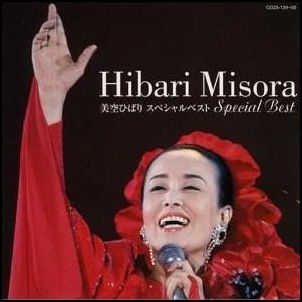
The most popular kayokyoku and enka singer was Misora Hibara, a beautiful singer-actress who emerged in 1949 at the age of 12 and remained popular until her death in 1989. In addition to being a popular singer she was the queen of cheerful Japanese B-movies like “Tokyo Kid, Three Girls” and “Growing Up” in the 1950s and 60s.
Known for her versatility, she continues to sell hundreds of thousands of recordings a year. Her most popular songs included “Yawara” (1964), “Ai san san” (1986) and “Kawa no nagre no yoo ni” (“Like the Flowering River” 1989).
Misora worked hard and made lots of money. She recorded over 1,200 songs and 675 albums and at her peak appeared in a new movie almost every month. She sold millions of record and was listed high on Japan's list of highest tax payers for many years in a row.
Misora’s fame also had a dark side. At one public appearance a fan was crushed to death when the crowd rushed forward. Another time an envious fan threw acid in her face. After that she sought protection from the yakuza and for that she was shunned by the media and her popularity declined. She didn't make a come back until it was widely known that she had a serious disease.
Misora performed a famous concert at the Tokyo Dome a few months before she died from hepatitis and gangrene, receiving constant injections of painkillers to get through the show.
Toshiro Mifune
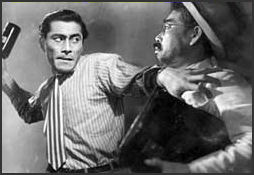
Toshiro Mifune in Drunken Angel Toshiro Mifune (1920-1997) is the actor associated most with Kurosawa's work. Born in China, he played stoic word-wielding samurai in many of Kurosawa's classics, including “The Seven Samurai, Yojimbo”, and “Rashomon”. Describing his first encounter with Mifune, who’d only been in Japan for a year, Kurosawa wrote: “A young man was reeling around the room in a violent frenzy. I was frightened as watching a wounded or trapped savage beast trying to break loose. I was transfixed.”
Mifune’s role as the drunken samurai-bandit in “Rashomon” is regarded by Chinese director Zhang Yimou as the one of the most charismatic performances of the 20th century, as good as anything done by Marlon Brando or James Dean. Washington Post Film critic Stephen Hunter described him as a “scruffy, growly samurai, loping along in a cloud of dust, slapping at gnats and ticks, three weeks on the far side of a bath...When he stops scratching, his eyes narrow and harden, and his hands dangle ominously near the long blade sheathed in his grungy sash...When it happens. It happens fast. He’s a whirl of grace and purpose and lethargy.”
Mifune was equally good playing a zoot-suited, jitterbugging gangster in “Drunken Angel” (1948) and a homicide detective who loses his gun only to find it used in a murder in “Straw Dog” (1949). Altogether Mifune appeared in 126 feature films, including 16 Kurosawa movies and the Hollywood films “Hell in the Pacific” (1968) and “Midway” (1976), and 17 televison films, including “Shogun” (1980).
Mifune’s sidekick in several Kurosawa films was Takishi Shimura, a Kurosawa regular.
Book: “The Emperor and the Wolf: The Lives and Films of Akira Kurosawa and Toshiro Mifune” by Stuart Galbraith IV (Faber & Faber, 2002)
Famous Japanese Actors in Hollywood
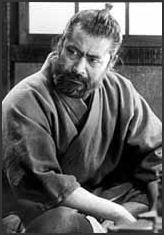
Toshiro Mifune
in Redbeard Japanese heartthrob Sessie Hayakawa was popular in the 1920s. He is best known in the West as the scowling prison camp commander of David Leans’s 1957 film “Bridge Over the River Kwai”. He made a name for himself 40 years earlier as romantic leading man, and was the first Asian actor to achieve genuine stardom in Hollywood. It was only after Rudolph Valentino arrived on the scene that his his star started to wan.
Hayakawa appeared in a number of silent films, including Cecil B Demille’s “The Cheat”, in which he plays a sadistic Japanese art dealer who enslaves a Long Island society woman, “The Wrath of Gods”, directed by Reginald Baker, and 23 features over a four year period with directors William Worthington of which “The Dragon Painter” (1919) received the biggest audience, In that film Hakayama plays alongside his Japanese-American wife Tsuru Aoki, whose love for an American sailor in the film provokes divine reaction in the form a huge volcanic eruption.
Yoko Shimada won the Golden Globe award for best actress in a television role in 1981 for her performance in “Shogun”.
Hollywood films about Japan often feature Chinese and South Korean actors playing Japanese characters as was the case in “Memoirs of a Geishas” and “The Fast and the Furious Tokyo Drift”. As of 2008, the U.S. Screen Actors Guild had 20 Chinese union members but only 11 Japanese members, including those of Japanese-American descent.
Japanese-American Actors
The Japanese-American actor Mako (1933-2006) was nominated for an Academy Award for his role opposite Steve McQueen in “The Sand Pebbles”. He also appeared in “Seven Years in Tibet” and “Memoirs of a Geisha” and did type-caste roles on shows like “McHale’s Navy” and “77 Sunset Strip”. He also distinguished himself on the stage, winning a Tony for his leading role in “Pacific Overtures”. Mako was born in Kobe and moved to New York with his family when he young.
Miyoshi Umeki (1930-2008) won an Academy Award for best supporting actress for her performance as the doomed wife on an American serviceman in the film “Sayonara” “the film version of a best-selling James Michener novel — in 1957. She also starred in the Broadway musical “Flower Drum”. She was the first Asian performer to win an Oscar.
Oddjob was the Japanese villain in the 1964 James Bond film “Goldfinger” who used his steel-rimmed derby with deadly efficient weapon. The role was played Harold Sakata.
Pat Morita is a Japanese-American best known for his roll as Mr. Miyagi in “Karate Kid”, and the diner owner in the television series “Happy Days”. He was born Noriyuki Morita to migrant farm workers and was sent to an internment camp in Arizona during World War II. He played Chinese and Koreans as well as stereotype Japanese roles on shows like “McHale’s Navy”. For a while in the 60s, he worked as a comedian, calling himself “the Hip Nip.” Morita was nominated for an Academy Award for his role in “Karate Kid”. He is remembered for his habit of trying to catch flies with chopsticks and his “wax on, wax off” training methods and his grasshopper karate stances.
George Takei is a Japanese-American actor who played Mr. Sulu on “Star Trek”. Known as “Mr. Kato” in Japan, he drew some attention when he came out and admitted he was gay. In May 2008, at the age of 71, after California overturned its ban on gay marriage, he announced his plans to wed his long-time partner 54-year-old Brad Altman.
Modern Japanese Actors
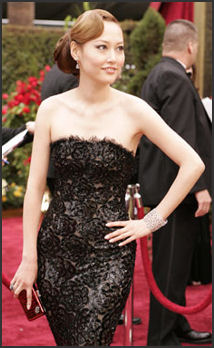
Rinko Kikucho Rinko Kikucho was nominated for an Academy Award in 2007 for best supporting actress for her role as a deaf-mute student Chieko in the film “Babel”. It was the first time a Japanese actress had been nominated for an Oscar in 50 years. The award was won by Jennifer Hudson in “Dreamgirls”. Kikucho played a teenager angry over her mother’s suicide who frustrates her father and aggressively pursues her sexual needs in modern Tokyo.
Tadanobu Asano played Genghis Khan in the Oscar-nominated film “Mongol”. Handsome and athletic, he was born in 1972 and has played a number of weirdos and killers and is regarded as one of the hottest actors in Japan. He appeared in his first television role when he wa14, a move he said that at least partly motivated his family’s need for money. By the age of 35 he had appeared in 46 films and directed a couple more. Asano is married to a musician, plays drums and bass in rock bands and occasionally DJ’s at Tokyo techno clubs. He also paints and designs clothes. His maternal grandfather was a Navaho from Kentucky who met his grandmother while serving in the American military in Japan but abandoned his family are returned o America.
Masayori “Masi” Oka is the Japanese-American star of the hit American television series “Heroes”. In the show he plays an otaku (nerd) with the power to stop time, transcend time and space and change the future and has made the Japanese exclamation “Yataa!” a buzzword in the United States. In real life Oka loves computers and manga and subscribes to Shonen Jump in the United States.
Oka was born in Shibuya ward of Tokyo and lived there until he was six when he moved to the United States with his mother. He was pictured on the cover of Time when he in primary school for a story on whiz kids (his IQ at that time was in the 180s). He attended Brown even though he was accepted at Harvard and took up acting after working at V.E.X. special effects studio owned by George Lucas that did all of work for the second “Star Wars” series.
The androgynous-looking singer-actor Takuya Kimura, or Kimitaku of Smap, routinely tops popularity polls among women and was named the most popular CM talent eight years in a row. He appeared in the acclaimed Chinese fil 2046.
African-American Dante was named the most popular CM talent in 2007 based on his appearance in a popular television commercial series for Softank cell phone sin which he is the eldest brother in family lead by a talking white dog.
Actress Shinobu Terajima won Silver Bear for Best Actress at the 60th Berlin International Film Festival in 2010 for her work in the film “Caterpillar” directed by Koji Wakamatsu. She was the third Japanese to receive the best actress award at the film festival.
The Japanese actress Eri Fukatsu received the best actress award at the 2010 Montreal World Film Festival for her role as the girlfriend of a man that had killed another girlfriend in the film “Akunin” (“Villian”).
Ken Watanabe
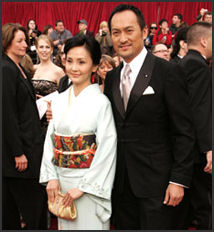
at the Oscars in 2007
with his wife Ken Watanabe was a star in “Last Samurai”, “Memoirs of Geisha” and “Letters from Iwo Jima”. He was selected as one of world’s “50 Most Beautiful People” by People magazine in 2005 and received an Oscar nomination for his performance in “Last Samurai”.
Watanabe played Lt. Gen Tadamicho Kuribayasho, the commander of the Japanese forces on Iwo Jima in “Letters from Iwo Jima”. Director Clint Eastwood said, “Besides being a terrific actor, he’s got a really great face. His face almost jumps off the screen. He’s almost the heir to Mifune, and I’ve always liked him and admired him in the few things I’d seen him in.” One fan called him a “a majestic hunk”.
In Japan, Watanabe made a name for himself playing a samurai in television series such as the 50-episode “Dokuganyru Masamune” (“One-Eyed Dragon, Masamne”) “Watanabe insists he is not a big star in Japan.
Watanabe is based in New York. He was born in 1959. He has been married twice. He had two children with his first wife. He divorced her in 2001. At a press conference at that time he said his ¥170 million home had been repossessed after he left the family finances to his wife. His son is an actor and model. In December 2005,Ken Watanabe wed Japanese actress Kaho Minami. It was the second marriage for her too. She added her daughter to the marriage.
Watanabe is known for being a sharp dresser, he likes to dress in black. He said his greatest enjoyment in life is walking his dog to stay fit and eating Japanese food. His English is reasonably good but he is accompanied by a translator when he does interviews with the American press.
Hiroyuki Sanada Stars with Anthony Hopkins in an Ivory Film
Yasuko Onda wrote in the Yomiuri Shimbun, “Hiroyuki Sanada and Anthony Hopkins play a gay couple as part of a distinguished ensemble cast in James Ivory's “The City of Your Final Destination” . Sanada's character serves as a liaison among the others, and his presence greatly contributes to making the film well worth seeing. [Source: Yasuko Onda, Yomiuri Shimbun, October 19, 2012]
For more than a decade, Sanada, 52, has been active both in Japan and overseas. In the drama set in Uruguay, a young man named Omar (Omar Metwally) visits the family estate of a writer who committed suicide, seeking permission to pen his authorized biography. Omar's encounters with the family members eventually give the characters a chance to review their respective lives. Sanada plays Pete, who has been the partner of the writer's elder brother Adam (Hopkins) for the past 25 years. The writer's widow (Laura Linney) and his former mistress (Charlotte Gainsbourg) are also residents of the estate.
This is Sanada's second appearance in an Ivory work, following The White Countess in 2005. The director, noted for his film adaptations of literary works, personally asked Sanada to perform in the film, Sanada said."Ah-ha! I see what he's up to," Sanada said he thought after reading through the script Ivory had handed him. "I saw that my role would be very important, serving as a kind of lubricant [among the other characters]," he said. "I was happy the director trusted me that much after I performed in the previous film. I also felt it would be a pretty serious challenge.”
Sanada said performing with Hopkins made a big impression on him. "As he took a different approach for each take, I couldn't have coped with him if I had performed in a fixed, preconceived way," he said. "In this respect, each take was fresh and exciting for me.” Sanada said the most memorable scene with Hopkins was filmed in one continuous shot. Sanada was beginning to feel that he was in the zone, as an actor, when Hopkins, who was walking by his side, suddenly patted him with an umbrella. It was as if indicating the intimacy of their roles. "I was happy at the pat," he said. "In response, my way of talking changed. Eventually, that changed his way of talking, too. I've had various experiences each time I've performed for films. As a result, I think I'm getting more and more able to enjoy the real thrill of these sessions.”
He has been based in the United States for some time, performing in art house films as well as Hollywood blockbusters and TV series.
Octogenarian Japanese Actor in Cannes on First Trip Abroad
Anne Chaon of AFP wrote: When Tadashi Okuno got a part in Iranian director Abbas Kiarostami's new film, the 82-year-old had never set foot outside of Japan. Now he is about to walk up the red carpet at Cannes. "As soon as shooting began, Abbas said to me: 'We'll go to Cannes together, you'll see'. And I said no, I don't want to, I don't like travelling abroad," he told AFP. "This is the first time I have ever left Japan. It's how I imagined it would be, its heritage has been well preserved."[Source: Anne Chaon, AFP, May 22, 2012]
Okuno plays a retired university teacher in Tokyo in "Like Someone in Love", one of 22 films vying for the Palme d'Or top prize to be handed out. He pays for the company of an exquisite and sleepy student and to save her embarrassment, ends up having to pretend he is her grandfather when the angry boyfriend turns up.
Okuno is discovering the grind and the joys of Cannes, doing back-to-back interviews with journalists in a hotel and getting ready to face the barrage of cameras for the climb up the red carpet at the beachfront festival palace. When his agent suggested he audition for Kiarostami's movie, he had never heard of the Iranian before. He nevertheless went along, hoping to get a small role in the film, like the many minor parts he has played on television. But when the director saw him, he immediately knew he was the man he was looking for and gave him the lead. "When I told my friends I had got the part, they were all very impressed. They told me he was a master film-maker. And I discovered that during the shooting," he said.
Kiarostami likes to work with non-professional actors, but in "Certified Copy", the first film he made outside of Iran and which took the best actress award here in 2010, he used French star Juliette Binoche. "He was looking for a 60-something university teacher. When we met and he decided to take me, he had to change the script. Twenty years older was a bit too much, he couldn't be in love with a young student. It wouldn't have been plausible.”
Okuno comes from the theatre world. After World War II, he joined Japan's Bengakuza troupe, which concentrated on modern work. Japanese directors often poached actors from the company for supporting roles in their movies and sometimes even used the entire group when they needed dependable extras.
Okuna admitted that he was "moved" at the idea of the red carpet gala. "I've watched the red carpet ceremony on television. And now it's for real, I am pretty impressed. And very happy." Okuno said Kiarostami wanted to work with him again. "But I told him I wasn't enthusiastic. I don't want to travel.
Japanese Acting Business
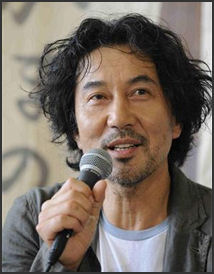
Koji Yakusho Japanese actors are not nearly as well paid as their Hollywood counterparts. The father of one actor told the Los Angeles Times, “No one gets rich in the Japanese movie industry. You have to take every part that’s offered.”
Actors are often controlled by massive talent agencies that exert control over their stables of actors like Louis B. Mayer did in the heyday of the Hollywood studios in the 1930s, 40s and 50s. The agencies have so many actors they can dictate casting decisions to producers and directors. Auditions are rare. Resistant by a producer can result in the punishment of being denied the best and most popular talent.
It is hard for a Japanese actors to really standout. The actor Tadanobu Asano told the Los Angeles Times, “Our artist are not good at expressing themselves. Ever since grade school we have been taught to all behave the same way. Its comfortable; you’re pretty much protected in that world. But to be successful you have to be different. And I was lucky that my father and mother encouraged me to be my own person.”
Asano said, “There are talented people here, but the agencies all want them to stay the same.” He said the going is particularly rough for actresses. “I’ve worked with actresses in Taiwan, Hong Kong and they are sexy, they know what the can offer. But in Japan no actress is doing such a thing. They can’t show what they have. They don’t take chances...Japanese actresses are not treated very well. Agents are always holding them back. The system will kill actresses.”
Asano belongs to an agency run by his father with eight clients, including Ryu Kase (Shimizu in “Letters from Iwo Jima”) and Rinko Kikuchi, who won an Oscar nomination for her role in “Babel”. Asano’s father Sato said, “We want to be something different; we want to establish a brand that people will recognize for skills and value . But it’s difficult in this country. People told me we are pushing too much.”
Foreign Stars in Japan
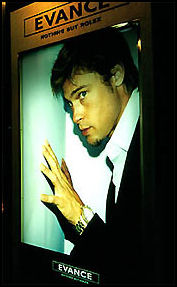 In many entertainment sectors Japan is the most highly-values market after the United States. Entertainers, actors, directors and pop starts inevitably make a stop in Japan if they have something to promote. Sometimes big Hollywood stars are jetted in on private plans for a few hours of press conference, meet and greets and a gala opening, and then fly home.
In many entertainment sectors Japan is the most highly-values market after the United States. Entertainers, actors, directors and pop starts inevitably make a stop in Japan if they have something to promote. Sometimes big Hollywood stars are jetted in on private plans for a few hours of press conference, meet and greets and a gala opening, and then fly home.
One of the biggest celebrities in Japan in the early 2000s was a 170-kilogram, NFL football reject turned kick boxer named Bob Sapp. He was big and black and Japanese kids loved him. He made millions doing commercials for Panasonic, an energy drink, a fabric softener and others. They fact that he lost many of his K-1 (kick-wrestling) fights didn’t seem to hurt his career.
A Japanese businessman erected a memorial near the intersection of Highways 41 and 46 in northern California at the spot where James Dean died when he crashed his Porsche Spider in 1955.
Charlie Chaplin in Japan
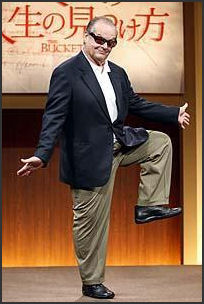
Jack Nicholson in Tokyo Charlie Chaplin visited Japan four times, worked with some kabuki actors and kept a Japanese aide and confidant, Toraichi Kono, by his side for 18 years. Chaplin is popular in Japan. He was first known as Strange Person and was later dubbed Professor Alcohol.
On one of his visits he was almost assassinated by a gang of rouge naval officers. In May 1931, six young naval officers broke into the official residence of the prime minister and murdered Prime Minister Tsuyoshi Inukai in hope of sparking a revolution to reinstate the emperor-based government. The officers were upset about the prime minister’s recognition of Chinese sovereignty over Manchuria and his staunch defense of parliamentary democracy. At the time Inukai’s son was attending a sumo match with the actor Charlie Chaplin. The plotters discussed killing Chaplin as a means of triggering a war between Japan and the United States.
During one his visits to Japan Chaplin became entranced by cormorant fishing on the Nagaragawa River in Gifu, repeating “wonderful” over and over as he witnessed the nighttime spectacle, and befriended master fisherman Kanji Yamashita, who lost his sight from burns to his eyes caused by sparks from the cormorant fishing bonfires, and once protected the fishermen from a thrashing cormorant.
Toraichi Kono was so often at Chaplin’s side he was called Chaplin’s shadow. Born in Hiroshima, Kono came to the United States at the age of 15 and later was employed by Chaplin as his chauffeur. Gradually he gained the actor’s trust and became his secretary and served in that position for 13 years and was even allowed to sign the actor’s checks, Kono’s long tenure was particularly noteworthy in that Chaplin was notorious for firing people for small trivialities. Kono was finally let go it is said because he was disliked by one of the actor’s girlfriends.
Hollywood Stars and Japanese Commercials
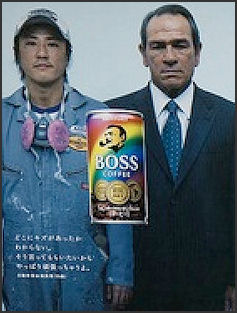
Tommy Lee Jones
for Boss canned coffee Many major American film and sports celebrities have shown up in Japanese television commercials: Arnold Swarzenegger appeared slurping noodles and guzzling energy drinks; Brad Pitt strutted around for Edwin blue jeans; Cameron Diaz chatted on Softbank cell phones; Jodie Foster endorsed Mount Rainier Café Latte and Keri Lotion; Catherine Zeta Jones did advertisements for Lux soap; Harrison Ford drank Kirin beer; Richard Gere endorsing the Dandy House men’s spa center; Ewan MacGregor plugged an English school; and Leonardo DiCaprio endorsed Suzuki cars. Music and sports stars are also sought after. Madonna dressed like a ninja to push a liquor called Pure; Tiger Woods promoted Woda canned coffee;
American stars do Japanese commercials because they don't have to do much to earn a lot of money and the appearances don't damage their reputation back home. Other personalities that have appeared in Japanese commercials include Robert Deniro, Kate Winslet, Woody Allen, Paul McCartney, Naomi Campbell, David Beckham, Sylvester Stallone, Mel Gibson, Antonio Banderas, Nicholas Cage, Bruce Willis, and Cindy Crawford. The first major American celebrity to appear in a Japanese commercial was Charles Bronson. In the early 1970s, he appeared in a spot for Mandom cologne, and said: "Hmmmmmm...Mandom."
By the mid 2000s, American celebrities were being displaced by Asian celebrities such South Korean actor Bae Yong Joon, star of the soap opera “Winter Sonata”, plugging chocolate candies; and Chinese actress Zhang Ziya (the “Crouching Tiger, Hidden Dragon” star) drawing oohs and aahs from envious Westerners in an ad for Asiance shampoo. Explanation for the trend are that Japanese feel a more direct bond to fellow Asians, American culture has lost some of its mystique and attraction and Hollywood stars demanded to much money.
Japaner.com shows Japanese commercials featuring Western actors.
Steven Segal
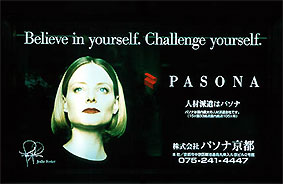
The action actor Steven Segal was the first non-Asian to open a martial art academy in Japan (he was once an aikido teacher in Osaka). In the 1980s, he left his Japanese wife and children to seek stardom in Hollywood. He opened a martial arts academy in Los Angeles and was discovered by super agent Michael Ovitz. Later he married an actress.
Segal starred in films like “Hard to Kill” and “Marked for Death”. In 1997, Dalai Lama's organization declared that Segal was a reincarnation of a lama and is therefore a "tukla," a sacred vessel of Tibetan Buddhism.
Brad Pitt “Inspired” by Japan’s Tsunami Recovery
In November 2011, AFP reported: Actor Brad Pitt praised the “tenacity” of Japan in its post-quake recovery efforts Thursday, as the star brought his partner Angelina Jolie and family to a nation still confronting a nuclear crisis. “You are bringing everything forward to rebuilding and reclaiming the lives for yourselves and for others. It’s valued and inspiring to us,” Pitt told a news conference ahead of the Japan release of his new movie “Moneyball.” “Your tenacity and perseverance and survival has a great effect on us, to the world community, and I applaud you all for that,” he said. [Source: AFP, November 10, 2011]
Pitt’s visit to Japan, together with Jolie and their six children comes nearly eight months after a 9.0 magnitude earthquake triggered a devastating tsunami that left 20,000 dead or missing. The global community is “greatly and painfully aware of the cataclysmic catastrophe,” Pitt said. “Our hearts and thoughts are still with you who have been touched by this event.” At the Moneyball’s preview, Pitt gave autographed balls to 10 teenage baseball players from the quake-hit northeast.
Image Sources: 1) Japan Zone, 2) Bright Kights, 3) Hector Garcia, 4) Hollywood actors, japan-photo.de japan-photo.de ;
Text Sources: New York Times, Washington Post, Los Angeles Times, Daily Yomiuri, Times of London, Japan National Tourist Organization (JNTO), National Geographic, The New Yorker, Time, Newsweek, Reuters, AP, Lonely Planet Guides, Compton’s Encyclopedia and various books and other publications.
Last updated January 2013

